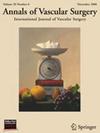Beyond Endovascular Solutions: Open Sac Revision with Graft Preservation for Persistent Aortic Sac Expansion Post-EVAR
IF 1.4
4区 医学
Q3 PERIPHERAL VASCULAR DISEASE
引用次数: 0
Abstract
Background
Aortic sac expansion after endovascular aortic aneurysm repair (EVAR) is associated with higher reintervention rates, late rupture, and long-term all-cause mortality. Endovascular options have limitations, and guidelines recommend open sac revision (OSR) if these fail. This study reviews the technique, indications, and outcomes for OSR following EVAR at Auckland City Hospital.
Methods
We identified all OSR cases with stent-graft preservation for aortic sac expansion post-EVAR at Auckland City Hospital from January 2010 to October 2023. Techniques included sac closure, plication, or omental wrapping. Cases involving infected grafts were excluded.
Results
Seventeen patients (median age: 82 years, predominantly male) underwent OSR, with a median follow-up of 3 years. The primary indication was sac expansion with type 2 endoleak in 88.24% of patients, while 2 cases were type V endoleaks. Intraoperatively, endoleaks were found in 94.12% of patients, with 88.24% having type 2 endoleak and 17.65% having type 3 endoleaks. Omentoplasty was performed in 58.82% of cases. Although not statistically significant, there was a trend toward lower endoleak recurrence with omentoplasty than sac closure. Reintervention for progressive sac expansion was required in 17.65% of patients (3/17), with 2 additional patients (11.76%) monitored for recurrent endoleak without further intervention. All patients were discharged, with 82.35% going home without needing rehabilitation. The median hospital stay was 7 days, and the 30-day mortality rate was 0%.
Conclusion
OSR with graft preservation is effective for sac expansion post-EVAR, facilitating endoleak identification and repair while avoiding aortic clamping. Ongoing surveillance is necessary.
超越血管内解决方案:针对主动脉瓣置换术(EVAR)后持续性主动脉腔扩张的开放式腔隙翻修术与移植物保留。
本文章由计算机程序翻译,如有差异,请以英文原文为准。
求助全文
约1分钟内获得全文
求助全文
来源期刊
CiteScore
3.00
自引率
13.30%
发文量
603
审稿时长
50 days
期刊介绍:
Annals of Vascular Surgery, published eight times a year, invites original manuscripts reporting clinical and experimental work in vascular surgery for peer review. Articles may be submitted for the following sections of the journal:
Clinical Research (reports of clinical series, new drug or medical device trials)
Basic Science Research (new investigations, experimental work)
Case Reports (reports on a limited series of patients)
General Reviews (scholarly review of the existing literature on a relevant topic)
Developments in Endovascular and Endoscopic Surgery
Selected Techniques (technical maneuvers)
Historical Notes (interesting vignettes from the early days of vascular surgery)
Editorials/Correspondence

 求助内容:
求助内容: 应助结果提醒方式:
应助结果提醒方式:


